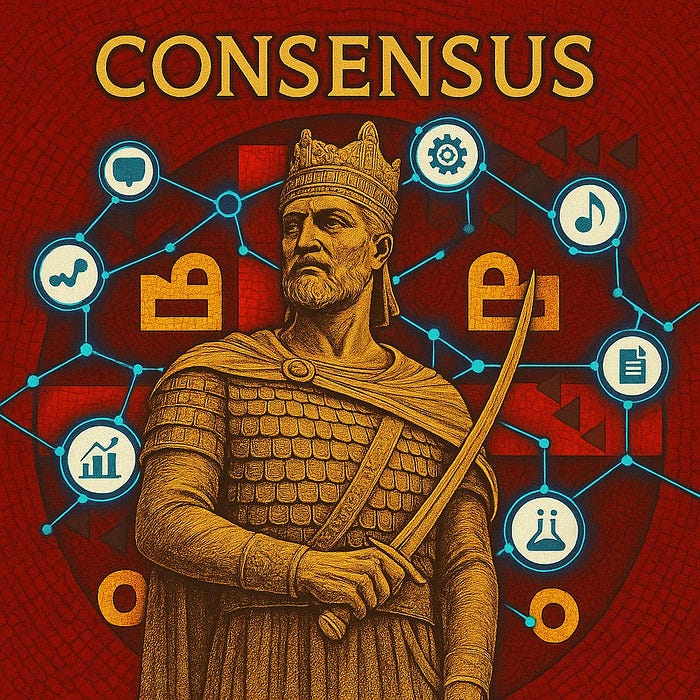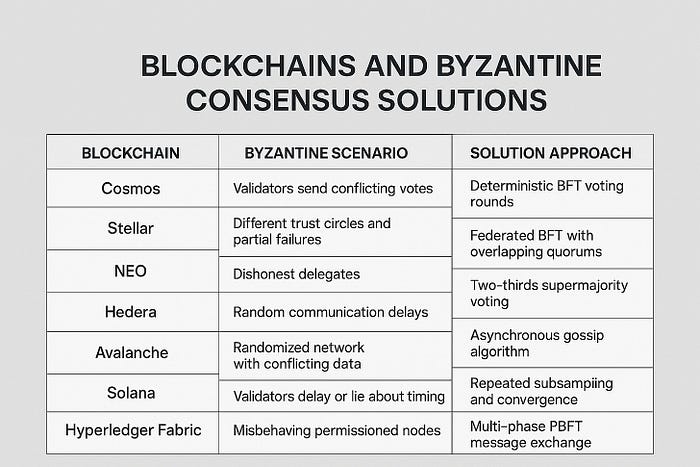The Empire of Trust: How Byzantine Consensus Keeps Blockchains Honest

Disclaimer:
This essay reflects my personal opinion only. It does not represent my employer’s views and is not investment advice.
Setting the Stage
The word Byzantine might remind you of marble domes and ancient intrigue, but in cryptography it means something far more practical: how to agree on the truth when you can’t trust everyone talking to you.
This idea, called the Byzantine Generals Problem, sits at the heart of blockchain technology. Every time you send crypto, vote in a DAO, or rely on a distributed ledger, the network faces the same ancient problem: what if someone tries to subvert the system and order?
Origin of the Term
The term traces back to a 1982 paper by computer scientist Leslie Lamport and his colleagues Robert Shostak and Marshall Pease, titled “The Byzantine Generals Problem.” They imagined several generals of the Byzantine Empire surrounding an enemy city. Each general commands part of the army. They can only send messages through couriers. Some generals might be traitors who send false orders.
To win, the loyal generals must agree on a single plan — attack or retreat — even if some generals are lying. That simple story captured one of the hardest challenges in distributed computing: reaching consensus when some participants are unreliable or malicious.
Why “Byzantine”? Because the Byzantine Empire was known for political intrigue and deception. In English, Byzantine came to mean “complex, full of hidden motives, and hard to navigate.” Lamport chose the word precisely because it conveyed the difficulty of finding truth in the midst of uncertainty.
A Breakdown of the Acronym “BFT”
Let’s break it down:
- Byzantine:
Refers to the idea that participants in a network can behave arbitrarily — not just crash or go offline, but actively deceive or send contradictory information.
In short: “Byzantine” means “possibly malicious.” - Fault:
A “fault” is any failure in the system — from hardware crashes to malicious attacks.
Some faults are honest (a node disconnects). Some are dishonest (a node lies). - Tolerance:
“Tolerance” means the system still works, even when some parts don’t.
So a Byzantine Fault Tolerant (BFT) system can handle bad actors and still reach consensus about what’s true.
Put together: BFT describes a system that can continue making correct decisions even when some participants act unpredictably or dishonestly.
Byzantine Generals Problem in Modern Consensus
Now imagine thousands of computers around the world, each keeping copies of the same ledger. Some crash, some lag, some are hacked. Each new block of transactions must be verified and added in the same order across all copies.
That’s today’s version of the Byzantine generals shouting across the battlefield. The “generals” are nodes, the “messages” are transactions, and the “traitors” are faulty or dishonest nodes.
A blockchain achieves Byzantine Fault Tolerance (BFT) when it can keep running and stay consistent even if a fraction of its nodes misbehave. Most BFT systems tolerate up to one-third of participants being faulty or malicious.
Blockchains That Use Byzantine Consensus
Several leading blockchains rely on Byzantine fault tolerance. Each faces its own version of the problem and solves it in a unique way.
Cosmos
Consensus: Tendermint BFT
Byzantine challenge: Validators might send conflicting votes.
Solution: Tendermint runs deterministic voting rounds where two-thirds of validators must agree. Even if one-third act maliciously, the honest ones remain in sync. Once a block is confirmed, it’s final — no forks.
Why it matters: Finality and predictability make Cosmos ideal for interoperable blockchains.
Link: https://cosmos.network/whitepaper
Stellar
Consensus: Stellar Consensus Protocol (SCP)
Byzantine challenge: Different trust circles and partial network failures.
Solution: Instead of global agreement, Stellar uses federated Byzantine agreement. Each node chooses its trusted set (a quorum slice). When enough overlapping slices agree, the entire network converges on consensus.
Why it matters: Stellar achieves fast, low-cost, decentralized agreement without needing a central coordinator.
Link: https://www.stellar.org/learn/stellar-consensus-protocol
NEO
Consensus: Delegated Byzantine Fault Tolerance (dBFT)
Byzantine challenge: Dishonest or non-responsive delegates.
Solution: Token holders elect delegates who validate transactions. Delegates vote in rounds, and a two-thirds supermajority finalizes a block.
Why it matters: Provides fast finality and high throughput — useful for regulated or enterprise settings.
Link: https://docs.neo.org/docs/en-us/basic/whitepaper.html
Hedera Hashgraph
Consensus: Asynchronous Byzantine Fault Tolerance (aBFT)
Byzantine challenge: Unpredictable network timing or malicious delays.
Solution: Nodes “gossip” about transactions, including what they heard earlier (“gossip about gossip”). From this web of information, the network mathematically determines consensus without a central clock.
Why it matters: Hedera achieves fairness and strong security even in unstable network conditions.
Link: https://hedera.com/papers
Avalanche
Consensus: Avalanche BFT (Snow protocol family)
Byzantine challenge: Conflicting transactions in a large, random network.
Solution: Each node samples a small random subset of peers and adopts the majority view. Repeating this process drives the entire network toward convergence.
Why it matters: Combines scalability with probabilistic finality — fast and energy-efficient.
Link: https://avax.network/papers/
Solana
Consensus: Tower BFT with Proof of History
Byzantine challenge: Validators may lie or delay about timing and order.
Solution: Solana’s cryptographic clock timestamps every event. Tower BFT builds on that sequence to achieve fast agreement, locking in earlier votes to prevent reversals.
Why it matters: Combines time-based ordering with Byzantine voting for unmatched speed.
Link: https://solana.com/solana-whitepaper.pdf
Hyperledger Fabric
Consensus: Practical Byzantine Fault Tolerance (PBFT)
Byzantine challenge: Misbehaving permissioned participants.
Solution: Nodes go through three communication phases — pre-prepare, prepare, and commit. Two-thirds must agree before any block is added.
Why it matters: Offers deterministic finality and auditability for enterprise networks.
Link: https://hyperledger-fabric.readthedocs.io/
Summary Table

Why Byzantine Consensus Matters
True finality. Once a block is confirmed in a Byzantine-tolerant system, it’s permanent. No risk of reversions or chain splits.
Faster settlement. Blocks finalize within seconds instead of minutes, enabling instant settlement for real-world use.
Energy efficiency. These systems rely on digital signatures rather than brute-force computation, dramatically reducing power use.
Resilience against complex failures. Byzantine models expect some participants to act maliciously and still guarantee honest agreement.
Enterprise reliability. Predictable, auditable performance makes Byzantine consensus attractive for finance, supply chains, and government systems.
Trade-Offs
Byzantine systems trade a bit of openness for reliability. Communication overhead grows as validator counts increase, which limits scalability. Some require semi-trusted environments to keep latency low.
Yet their security and finality make them the backbone of mission-critical blockchains. For networks where certainty matters, Byzantine consensus is the quiet engine of trust.
Closing Toughts
Every blockchain is a modern echo of that old Byzantine riddle: Can we still agree if someone lies?
Byzantine consensus is more than an algorithm — it’s a philosophy of resilience. It assumes the worst, plans for it, and keeps going anyway.
When you see a blockchain that guarantees finality, tolerates faulty nodes, and runs without pause, you’re seeing Byzantine fault tolerance in action — the invisible guardrail of digital truth.
References
- Lamport, L., Shostak, R., & Pease, M. (1982). The Byzantine Generals Problem. ACM. https://lamport.azurewebsites.net/pubs/byz.pdf
- Buchman, E., Kwon, J., Milosevic, Z. (2018). The Latest Gossip on BFT Consensus. arXiv. https://arxiv.org/abs/1807.04938
- Cosmos: The Internet of Blockchains (Whitepaper). https://cosmos.network/whitepaper
- Tendermint BFT Consensus Algorithm (Cosmos Academy). https://cosmos-network.gitbooks.io/cosmos-academy/content/introduction-to-the-cosmos-ecosystem/tendermint-bft-consensus-algorithm.html
- Stellar Consensus Protocol (SDF). https://www.stellar.org/learn/stellar-consensus-protocol
- García-Pérez, Á., Schett, M. (2019). Deconstructing Stellar Consensus. Dagstuhl Reports. https://drops.dagstuhl.de/entities/document/10.4230/LIPIcs.OPODIS.2019.5
- Formal Security Analysis on dBFT Protocol of NEO. https://arxiv.org/abs/2105.07459
- Consensus mechanism — NEO (Docs). https://docs.neo.org/docs/en-us/basic/whitepaper.html
- Hashgraph Consensus — Hedera Docs. https://docs.hedera.com/hedera/core-concepts/hashgraph-consensus-algorithms
- Hedera Whitepaper v2.1. https://hedera.com/hh_whitepaper_v2.1-20200815.pdf
- Scalable and Probabilistic Leaderless BFT Consensus through Metastability (Avalanche). https://arxiv.org/abs/1906.08936
- Avalanche Consensus Overview. https://build.avax.network/docs/quick-start/avalanche-consensus
- Solana Whitepaper. https://solana.com/solana-whitepaper.pdf
- Tower BFT — Solana’s High-Performance Implementation of PBFT. https://solana.com/news/tower-bft--solana-s-high-performance-implementation-of-pbft
- Consensus on Solana (Helius Dev Blog). https://helius.dev/blog/consensus-on-solana
- Hyperledger Fabric Docs. https://hyperledger-fabric.readthedocs.io/
- Challenges of PBFT-Inspired Consensus for Blockchain. https://www.mdpi.com/1999-5903/12/8/129
- HotStuff: BFT Consensus in the Lens of Blockchain. https://arxiv.org/abs/1803.05069
- Bottlenecks in Blockchain Consensus Protocols. https://arxiv.org/pdf/2103.04234v2.pdf
Listen To The Article

Black Friday 30%
Offer









